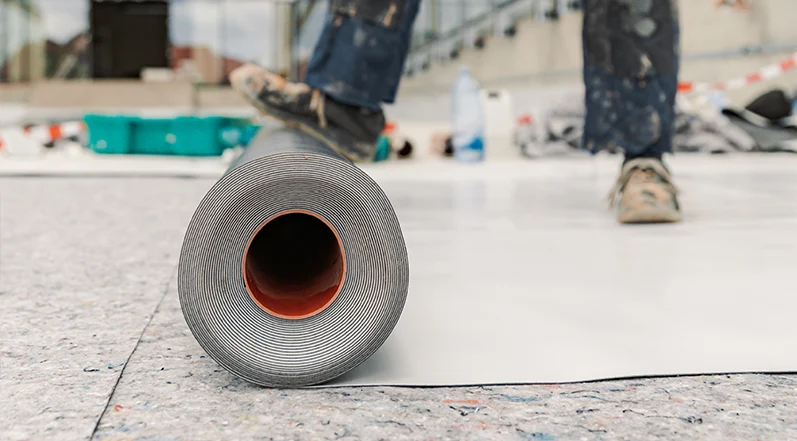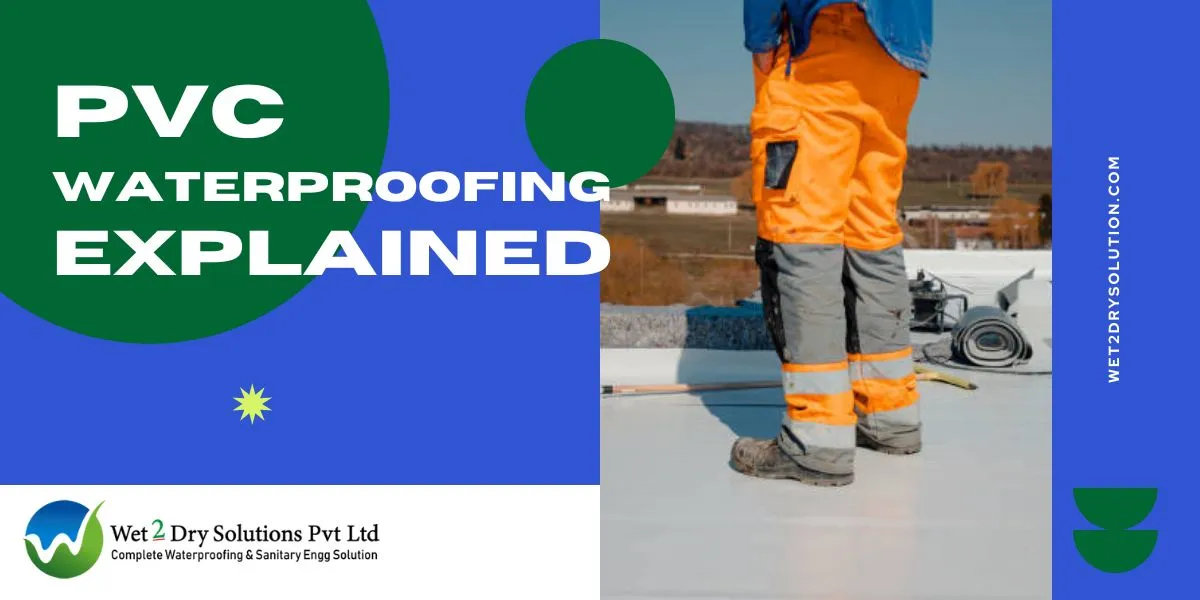PVC waterproofing explained
Every building needs a waterproofing system that prevents water penetration, dampness, and deterioration of the building elements. It keeps the moisture out of the facility and prevents it from structural damage. The right time to waterproof the building is during the structural phase of the construction work before the application of finishes, so that it will not be affected by the humidity.
In recent studies, it has been reported that almost 83% of building defects are due to water damage and failed membranes. so to avoid this, the structures are to be waterproofed with the correct choice of waterproofing membranes and their application. Though there are different waterproofing materials available in the market like cementitious coating, EPDM rubber, thermoplastic, bituminous membrane, etc., PVC waterproofing membrane is considered one of the best waterproofing materials for external, below-ground, and green roof applications.
What is PVC waterproofing?

PVC also called Polyvinyl chloride, is a synthetic rubber that is made of vinyl chloride polymerization. The membranes made of PVC are used to waterproof the buildings with their exceptional features and give a long service life to their structure.
Properties of PVC waterproofing membrane:
- Best waterproofing protection to the structure.
- Resistant to UV radiation.
- Flexible to both freezing and warming climates.
- Good dimensional stability.
- High durability.
- Easy repair and maintenance.
- High elongation properties.
- No curing time.
- Uniform thickness.
- Compatible with PVC fittings.
- Fast to mount.
- Variety of color choices.
Its main advantage over the other products is that of homogeneous connection in joints, penetrations, outlets, drains, and overlaps. PVC membranes are best applicable to wet areas such as balconies, bathrooms, decks, laundry rooms, industrial and residential roofs, shower walls, foundations, reservoirs, drinking water tanks, channels, tunnels, garage floors, pools, spas, siding, etc., Forsoc Brushbond coating is an acrylic polymer that acts as an excellent waterproofing barrier for concrete and masonry structures.
How to install PVC waterproofing membrane?

Depending on the project requirements, PVC waterproofing membrane can be installed in a variety of ways. Some of the installation tips are as follows:
Whereas terraces without tiles just have to undergo regular normal waterproofing which will cost less money than laying tiles and you don't have to worry for the next 15 to 16 years.
- The substrate or the surface of the application should be clean, dry, and free of dirt before starting the procedure.
- Based on the substrates (metal deck, concrete, or timber) the thickness of the PVC membrane varies.
- The manufacturer’s instructions are to be carefully followed during the application process and the curing times.
- To ensure proper adhesion, primers are to be used on the porous surfaces.
- Inspection has to be done after the installation process to ensure that there are no gaps or leaks.
The professional plumbing services help to install, fix and maintain the pipes and fixtures in good condition. This greatly helps the waterproofing team to do their job with ease and give the best results.
Step-by-step application process:
Step 1: The first step is always to clean the surface thoroughly for better adhesion. Typically pressure washing is used for cleaning the substrate as it helps to expose the details that need treatment. The surface is then dried using an air blower or torches.
Step 2: The next step is to apply the primer to the whole surface if it is porous or uneven. Before applying the primer, care should be taken that the surface must be completely dry.
Step 3: Silicon seal is used to fill the gaps and the excess is removed using a paint scraper. Let it rest for 24 hours before you start applying the waterproofing membrane.
Step 4: Before the installation of the PVC membrane, an ISO or EPS foam board should be used for the insulation. This helps to save energy by reducing the heat loss.
Step 5: Regardless of the procedure, all the PVC waterproofing membranes are sealed with the hot-air welder. This ensures the seam strength and membrane resistance to wind blow-offs and leaks.
Step 6: There are three types of installation followed for PVC waterproofing membrane.
Fully-adhered assembly installation: In this case, a PVC membrane is attached to the substrate using a special adhesive. This process is recommended when PVC membranes cannot be easily attached using screws or fasteners. The drawback of this installation is that this is suitable for temperatures above 45°F. Otherwise, the membrane will not bond properly to the substrate causing bubbles and delamination problems.
Mechanically-attached assembly installation: In this type of installation, the PVC membrane is mechanically attached to the substrate using the barbed plates and screws. This is highly recommended to use in buildings that are located along the coast line, high hill, or high wind areas where the membranes are held tight to the surface without damages.
Ballasted installation: In this type of installation, the PVC membrane is laid across the substrate loosely without any glue or screws. The membranes are held in place with the ballast which could be made of concrete pavers, washed river rocks, etc., With good maintenance, PVC waterproofing membrane can last for almost 50 years without losing its reliability and its best characteristics. The PVC waterproofing in Mumbai costs between Rs.75 to Rs. 125 / square meter.
The PVC waterproofing is environmental friendly and recyclable even after many years of use. So waterproofing should not be skipped on any of the building projects as the cost, time and effort are worth it. For best results, always consult the waterproofing experts for the right choice of materials and their application.